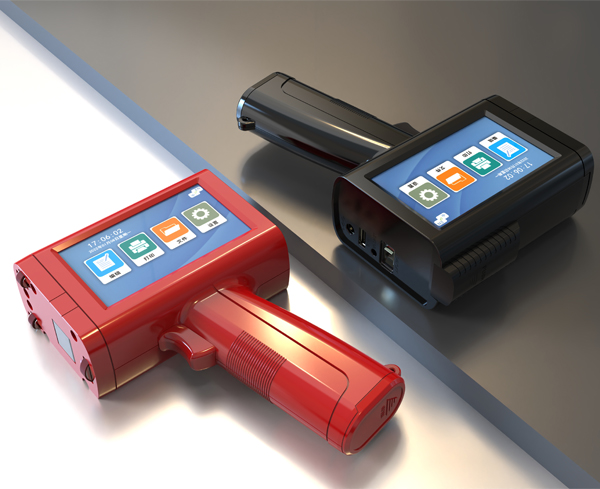Traditional inkjet printers have been used to print product specifications and expiry dates on products. However, the latest handheld inkjet printers with the increased convenience of printing in warehouses and stores without power cables or weight restrictions, it has become a trend among companies that manufacture various goods.
Handheld inkjet printer, also known as portable inkjet printer, is a convenient inkjet printer. It can be carried with you for printing, light and simple to operate. The handheld inkjet printer is different from the online inkjet printer, it is suitable for enterprises that do not require high production speed. Printing products need a certain size, there are various fonts such as solid, dot matrix, hollow body and colorful cloud body, which can be sprayed with trademark patterns, English fonts, numbers, barcodes, QR codes, and the printing height is generally about 1-57mm. , Different materials have different types of inkjet printers.
The development trend of hand-held inkjet printers is more and more light and compact, functional and information-based, and light and compact allows the staff to operate for a long time without getting tired; the improvement of functions, such as the improvement of editing software, allows even the work of elementary school students. People can easily get started; informatization, such as the concept machine of the German handheld inkjet printer Industry 4.0, enables high-level real-time interconnected mobile inkjet printing.
Applicable Occasions
The handheld inkjet printers are mainly used for large and large-scale, special-shaped, various types, frequent information changes, variable identification positions, and it is impossible or difficult to achieve large-scale and pipelined production conditions. Such as heavy industry enterprises, on-site construction teams, no Production line distributors, logistics distribution centers, etc.
Applicable Printing Surfaces
Handheld inkjet printers are widely used in various industries and materials. Any material can be printed by handheld inkjet printer, as long as the surface of the material is dry. For example, metal, plastic, wood, aluminum foil, paper, leather, fabric, film, glass and other material surfaces can be printed to get good printing results.
Printable Contents
Handheld inkjet printers are great because they can print numbers, text, logos, dates, times, invisible characters, and barcodes. They are perfect for printing traceability information on packaging for various products.
Applications of Handheld Inkjet Printing
The Food Industry
Handheld inkjet printer guns can help the food industries to make food traceability possible, such as eggs, beverages, canned food, bottled beverages, and condiments. It can quickly mark crates and product packaging for product batch numbers, production dates, shelf life, promotional information, trademark patterns, QR codes, product codes, Dealer code, etc.
Automotive and Aeronautic
The automotive and aeronautic industries use portable handheld inkjet printer to mark vehicle parts, such as screws or bolts. This can be a life-saving technology for assembly technicians who are often under pressure on the factory floor during their work hours!
Additionally, there are many other applications where this type of equipment is being used within those two fields, including safety signage that warns workers away from dangerous machinery to prevent accidents. A good example would be an airborne fighter jet; each component has specific markings that place when put together correctly by another member working alongside them.
Building Material Industry
Building materials usually include products such as pipes, profiles, plates, and integrated ceiling gussets. Building materials suppliers or construction workers use hand-held inkjet printers to mark information, such as production date, shelf life, product batch number, serial number, QR code, barcode, graphics, etc.
The production environment of the building materials industry is generally full of dust and electrostatic interference, which can easily cause the blockage of the nozzle and the poor printing effect. There are strict requirements on the protection level of the inkjet printer.
The Medical Industry
For traceability purposes, the pharmaceutical and medical industry uses handheld inkjet printer to mark the outer packaging of equipment, medicine bottles, etc.
Warehousing and Logistics Industry
Handheld inkjet printer is easy to operate, light and compact, and is widely used in the warehousing and logistics of large items and outer packaging in the logistics express industry and other industries. Through simple editing operations, labels can be clearly and quickly printed, such as time, batch number, description, Barcodes, trademarks, precautions and other information can be spray-printed on rough and uneven surfaces to save labeling costs, and it is suitable for marking on various types of outer packaging.
Military
Military supplies are best marked with inkjets so they can be identified easily. Printing on military barracks to identify fabrics for uniforms and exercise kits makes it possible to save time when distributing these assets.
Other uses
From creating fabric to indoor signs, people use handheld inkjet printers for various purposes. Some of the most common are labeling disassembled prefabricated structures like buildings and furniture from the designing area to the assembly store. There is also a possibility of branding fabrics or making signage based on daily printing requests.
Advantages of Handheld Inkjet Printer
- Machines are more efficient and faster compared to dot-matrix printers
- Handheld printers have higher resolution
- They produce finer details compared to dot-matrix printers
- Printers require no-to little warm-up time compared to laserjets printers
- They are compatible with solvent-based or water-based inks
- Most handle printers are not connected to power cable when used
- They come in an easy and lightweight design
Disadvantages of Handheld Inkjet Printer
- Once the printer comes in contact with water, it can produce prints that smudge due to the water-based ink.
- The ink cartridge can be blocked after some time.
- It requires regular maintenance.
- In general, inkjet printers are known to have a shorter life span compared to laserjet.
Conclusion
If you’re looking for the best handheld inkjet printer, next article how to choose the handheld inkjet printer will help you find what’s the most suitable.
